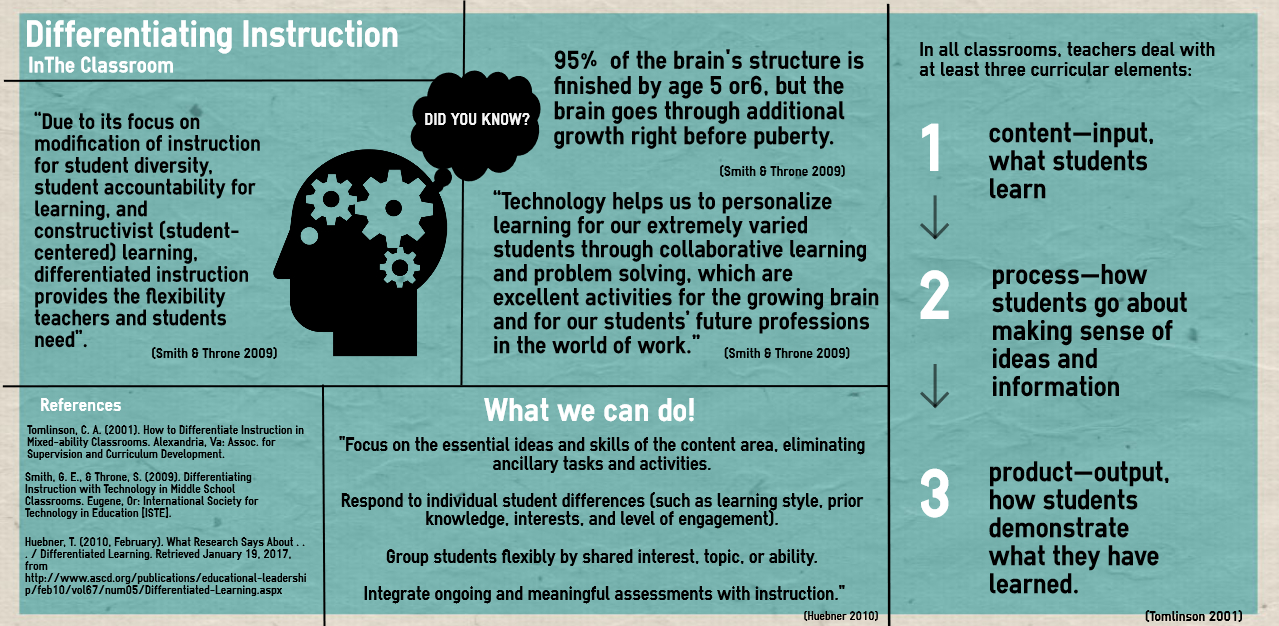I created this info-graphic at easelly to help you and me better understand what differentiated instruction is. I read through the chapters and a few online resources and the info-graphic is what I got out of it. Differentiated instruction requires that we take the time to get to know our students and create lessons based more off of that information then a scheduled curriculum. Something that I read from How to Differentiate Instruction in Mixed-Ability Classrooms that really stuck with me. It was talking about how differentiating instruction in classroom should not be hard, but something that flows. I think the "What we can do!" section of the info-graphic is most helpful for me to keep in mind when thinking about lesson plans classroom life. In a article by Weselby I found more information about the physical classroom environment. She explained that it would be good for there to be places for groups of students to work as well as students who want to work on there own. I liked that she talked about students who want to work on there own. I think that this can be forgotten in the process of room setup. This is my first info-graphic and I look forward to working with them again.
References
Huebner, T. (2010, February). What
Research Says About . . . / Differentiated Learning. Retrieved January 19,
2017, from http://www.ascd.org/publications/educational-leadership/feb10/vol67/num05/Differentiated-Learning.aspx
Smith,
G. E., & Throne, S. (2009). Differentiating Instruction with Technology in
Middle School Classrooms. Eugene, Or: International Society for Technology in
Education [ISTE].
Tomlinson,
C. A. (2001). How to Differentiate Instruction in Mixed-ability Classrooms.
Alexandria, Va: Assoc. for Supervision and Curriculum Development.
Weselby, C. (2014, October 1). What is Differentiated Instruction?
Examples of How to Differentiate Instruction in the Classroom. Retrieved
January 19, 2017, from
http://education.cu-portland.edu/blog/teaching-strategies/examples-of-differentiated-instruction/
Weselby,
C. (2014, October 1). What is Differentiated Instruction? Examples of
How to Differentiate Instruction in the Classroom. Retrieved January 19,
2017, from
http://education.cu-portland.edu/blog/teaching-strategies/examples-of-differentiated-instruction/
Weselby,
C. (2014, October 1). What is Differentiated Instruction? Examples of
How to Differentiate Instruction in the Classroom. Retrieved January 19,
2017, from
http://education.cu-portland.edu/blog/teaching-strategies/examples-of-differentiated-instruction/

As a high school math teacher, I have always thought that kids in a specific math class are grouped according to their "ability" since there are an array of math classes, (Pre-Algebra, Algebra, Geometry, etc.) but how wrong can I be! I still need to determine students' weak areas, and those "holes" in their math education that will hinder them to learn new content. It's a challenge for me to determine this for every kid in my classes. I do think technology will and would help with this!
ReplyDeleteChelsea, You did a great job on your first infographic! I really like the flow chart you made on the three curricular elements. I believe that teachers automatically differentiate in their classrooms and they don't know they are doing it. There is always more we can do and that is where we focus. It is good to realize and recognize how we are already differentiating and look to those successes to find more or new ways to differentiate. Reflection on current practices is important and I think many teachers forget to do that because we always feel like we aren't doing enough.
ReplyDeleteThank you Cherie. I totally agree that it is so easy to think that we as teachers are not doing enough. I am sure we can always learn and do better, but for the most part we are usually doing more then we realize. When I ask teachers about specific classroom theories some will say that they are not sure what it is. Then if I explain the theory they will usually say "oh yeah, I do that."
DeleteI tried to comment on your blog a few days ago and found that you have no comment section. Maybe that is something you can change in the settings.
DeleteI agree with you that differentiating should flow! It's easy to get lost/sidetracked in our goal for each student, but if we keep the essential goal at the forefront of our mind then it won't be as complicated. Differentiating for our lower students, at grade level, and above grade level students should be seamless as we design our lessons.
ReplyDeleteKeeping the "essential goal at the forefront of our minds" made me think about the UBD lesson frame work. How it is really important to make sure you have a solid frame work to make sure that what you are teaching is on topic and going somewhere.
Delete